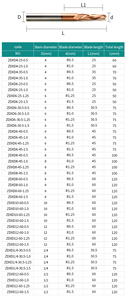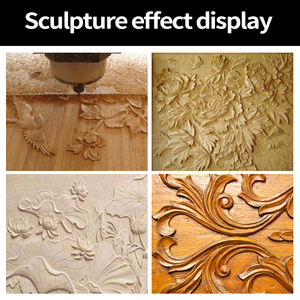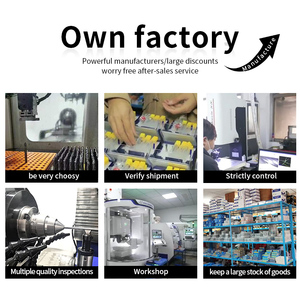Types of Spherical Taper End Mill
Spherical taper end mills are meant for different applications, depending on the exact shape and angle of the spherical and taper parts.
-
Two-Flute Spherical Taper End Mills
The main uses of these simple tools are contouring, slotting, and machining soft materials. The two cuts provide a good chip removal and work with flexible materials like aluminum to prevent clogging and improve cutter life.
-
Four-Flute Spherical Taper End Mills
These are meant for harder materials where a finer finish and faster feed rates are useful. The additional flutes provide better chip clearance but at the cost of less aggressive cutting action, making them suitable for materials like steel and titanium.
-
Half Spherical Taper End Mills
Half-spherical end mills are useful for making deep, round cavities or fillets in molds and dies. The exact shape improves efficiency by allowing complete cuts without the need for multiple tools. This saves time and effort when crafting complex 3D shapes in materials like hardened steel.
-
Semi-Spherical Taper End Mills
Like the half type, semi-sphericals are CAD appropriate for shallow and medium-depth recesses. Their radii enable broad fillet cutting and corner finishing, which is beneficial for mold makers needing versatile tools for different jobs.
-
Ball Spherical Taper End Mills
The ball shape permits corner radiusing and is suitable for 3D work. The rounded tips come in handy for sculpting models and creating smooth transitions. In surface finishing, ball mills polish surfaces more evenly than flat bottoms, especially on complex designs.
Features of Spherical Taper End Mill
A tapered ball end mill combines the functions of a taper ball end mill and skilled cone by tapering the spherical end to allow angled surface machining while retaining hemisphere radius capabilities for 3D contours. Key features include:
- Spherical Taper End Geometry: This allows the tool to create inclined surfaces while still being able to generate spherical profiles. Basically, such a tool can cut along the tapered shaft at a specific tilt angle and also produce curvature at the end of the mill.
- Multi-Flute Design: More flutes are added as the diameter gets larger because they increase the flute count. This helps with chip removal and makes smoother cuts possible. However, too many flutes can reduce mill efficiency, so there needs to be a balance.
- Hardened Steel Alloys: Tough materials with high melting temperatures enable these mills to machine hardened metals without wearing down. The alloys also withstand thermal stresses from high-speed cutting.
- Coatings: Common coatings applied to these mills include Titanium Aluminum Nitride (TiAlN) and Zirconium Nitride. The coatings give the mills wear and heat resistance, drain away lubrication well, and prevent material sticking so the mills last longer.
How to Choose Spherical Taper End Mill
Selecting the ideal tapered end mill depends on key factors:
- Slope Angle: The specific taper angle requires determining the correct taper for producing angled cuts at the desired incline. shallower taps are for gentler slopes, while steeper taper mill should be for sharp angled machining.
- Flute Count: Greater flute counts give better chip evacuation in wide cuts, while lower counts suit fine tasks. Too many flutes can compact the work material and cause breakage.
- Spherical Radius: It's important to choose the right spherical radius to avoid unneeded material elimination. Smaller radii permit subtle security finishing cuts, while bigger diameters rapidly remove bulk substance in roughing operations.
- Coating Selection: The coating picked must also be suitable for the workpiece material. Titanium aluminum nitride has superior heat endurance and is applied to steels. Zirconium nitride also resists adhering and suits aluminum.
- Material Considerations: Operations involving difficult substances such as titanium and hardened steels should employ tools made of superior alloys. Coated versus uncoated end mills need evaluation based on budget and usage demands too.
How to use Spherical Taper End Mill
Some of the ways to use a tapered ball end mill effectively include:
- Choosing the Right Machine: These tapered ball mills should be used on CNC routers and machining centers that can control the 3D movements needed to make curvilinear cuts.
- Fixing the Workpiece: Properly securing the material, such as by using vises or clamps, helps ensure accuracy as outside forces from the cutting may shift the unbound item.
- Selecting Cutting Parameters: Before starting the cutting, factors like speed the spindle and milling's feed should be worked out. During cuts, feeds must also be decreased as cuts go deeper or wider to avoid the mill from snapping off due to too much force.
- Starting the Cut: Starting to engage the mill into the material should be done slowly to prevent unexpected breakages. The mill's coolant must also be turned on to avoid the mill and workpiece from overheat and damage.
- Monitoring Progress: Closely checks on the cut aid finish watched so the intended cut doesn't go off track. Any signs of abnormal behaviour from the mill like wearing call for instant stopping cuts to switch worn tools.
- Post-Cut Care: When finished cutting comes the time to clean both workpiece and tool within coolant and chips, monitor the mill for unnecessary damage and wear. Inspections may lead to frequent sharpening or replacement.
How to DIY or Replace Spherical Taper End Mill
Diy tapered ball end mill is a challenging task, especially with operating end mills that incorporate carbide tips. However, replacing worn-out spherical end mills can be done with simple steps. Here are the DIY and replacement processes:
-
DIY Spherical Taper End Mill
Creating a tapered ball end mill demands machine shop know-how, special equipment, and tough materials. The main machine used is a CNC grinder, which carves the end mill shape. To hold up to cutting hard metals, the end mill body must be made of solid carbide or high-speed steel alloy.
The grinding process involves forming the spherical radius at the tip while also establishing the taper angle that slants down the length. This requires skill to create a smoothly transitioning cut.
-
Replacing Spherical Taper End Mill
Replacing a worn-out spherical end mill is easy. First, the collet or holder that secured the old mill must be removed. Next, the new spherical end mill is fitted into the collet or holder. The mill is then secured tightly onto the machine's spindle. Finally, the replacement is properly positioned and secured into the right place, achieving the desired task.
Benefits of Spherical Taper End Mill
- Combined Functionality: Spherical taper end mills are multi-purpose tools that incorporate the features of tapered ball end mills and regular ball end mills.
- Complex Profile Machining: Because they can both mill angled and curved surfaces, spherical taper end mills are ideal for creating complex 3D shapes.
- Improved Surface Finishing: The smooth spherical tip of these end mills helps achieve better surface finishes compared to flat-ended mills, which is crucial in industries where surface texture matters.
- Greater Versatility: Spherical taper end mills can be used for different jobs and across various industries.
- Reduced Tool Change: Combining the functions of two tools into one, sphericals, reduces the need for frequent tool changes.
- Time and Cost Efficiency: The dual functionality and versatility of spherical taper end mills lead to significant time and cost savings.
Q&A
Q1: What are the main uses of spherical taper end mills?
A1: These end mills can machine angled and curved surfaces, making them suitable for 3D contouring, die, and mold work, surface finishing, and more in aerospace and automotive industries, among others.
Q2: How do spherical taper end mills enhance surface finishing?
A2: The smooth spherical tips of these end mills help make the workpiece have better finishing compared to flat-ended mills, thus improving the surface texture finish of machined parts.
Q3: Are there special requirements for using CNC machines with spherical taper end mills?
A3: The CNC machines should allow precise control of 3D movements, feeds, speeds, and taper engagement angles to use effectively.
Q4: How should spherical taper end mills be stored to last long?
A4: The end mills should be stored in dry, protective cases or inserts where they will not contact one another or other hard objects to avoid chipping, bending, and wearing down the cutting edge.
Q5: Can any material be safely machined with spherical taper end mills?
A5: Spherical taper end mills come in coated and uncoated variants. Coated end mills are used on specific materials to reduce the impact and friction that will be directed toward the end mill, while uncoated end mills are cheaper and can also serve various functions.


















































